Brazil Travel Information
Here you can find all important information for the planning of your trip to Brazil. Find out about the entry and exit requirements, vaccinations and facts about the country.
You can stay in Brazil for up to 90 days without a visa. Your passport should be valid for anther 6 months after your planned departure. You can extend the stay for another 90 days at the Federal Police.
For the custom regulations at your reentry to Canada/UK please see special regulations at Global Affairs Canada or the Foreign and Commonwealth Office.
It's recommendable to have standard vaccination (tetanus, diphteria, pertussis and possibly mumps, measles, German measles, influenza and pneumococcus) and additionally a vaccination agains hepatitis A. If you are planning a longer stay you should think about a vaccination agains hepatitis B, canine madness, and typhus.
Yellow Fever
The WHO recommends a Yellow Fever vaccination for the visits of the reigions Rio de Janeiro and Sao Paulo. Excluded are the city regions Rio de Janeiro, Niterói, Sao Paulo and Campinas.
The Yellow Fever vaccination is not obligatory by the Brazilian government but possibly by governments of other countries in case of further travels because some regions are declared as endemic regions (Acre, Amapá, Amazon, Distrito Federal (including the capital Brasilia), Goiás, Maranhao, Mato Grosso, Mato Grosso do Sul, Minas Gerais, Pará, Ronônia, Roraima and Tocantins). In the states of Bahia, Paraná, Piauí, Rio Grande do Sul, Santa Catarina and Sao Paulo only few regions are affected. If you are planning a trip to the Iguazu Waterfalls a vaccination is recommended. For travels to the northern and southern coast it's not necessary.
Zika virus
Despite decreasing numbers an infection with the Zika virus is still possible and ,especially for unborn children, hazardous to health. Pregnant women or women, who are planning to get pregnant in the following two months after the trip are recommended to not travel to the affected regions. The virus is transmitted by mosquitos, a sexual transmission is possible as well. At the moment there is no vaccination or other protection available.
Dengue
The number of infections is increasing. The symptoms are fever, rashes and growing pains and are often similar to the flu. There are four different types of the virus, which makes repeated infections possible. The sickness can lead to death, especially for children living in the area.
Chikungunya
Especially in the states of Alagoas, Amapa, Amazon, Bahia, Mato Grosso du Sul, Minas Gerais and Roraima infections are possible. The virus is transmitted by the diurnal Aedes-mosquito.
Leishmaniasis
Leishmaniasis is transmitted by sandflies, which is leading to an infection by parasites. The parasite is attacking the skin, organs and mucosas.
Malaria
Malaria is transmitted by the nocturnal Anopheles-mosquito. The onset of the sickness can be weeks or even months after the infection. Inform your doctor, that you were staying in Malaria-regions if you are experiences fever after your travels.
In the rainforest- and savanna-regions you have a risk of infection all year. Only the east coast (also Fortaleza and Recife), the majority of city centres and the Iguazu is delcared Malaria-free.
Brazilian spotted fever
Since 2016 particular cases of infections were reported in the state of Sao Paulo. The sickness is transmitted by ticks. Symptoms are fever, rashes, headackes and growing pains, vomiting and pains in the abdominals. It get dangerous to life if lungs, kidneys and gastrointestinal tract are infected.
Because most of the infections named above are transmitted by mosquitos or ticks, the following protection measures are recommended:
- use insect repellents for skin and clothing
- wear bright and long-sleeve clothing + long pants
- it recommendable to sleep under a mosquito net
Diarrhea sickness
Protect yourself from sicknesses by avoiding tap water. Use boiled or filtered water or use byed water, even for brushing your teeth. Alway peel or cook your foods. Wash your hands as often as possible.
Like in most Latin American countries, the hospitals in big cities are on a western standard. In rural areas you are most of the time confronted with administrative, hygienic and logistical differences. Most of the time, even in private clinics, you need to pay the treatment beforehand. There are English-speaking doctors.
Travel Facts for Brazil
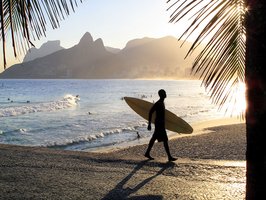
Most of Brazil is located in the southern hemisphere, which means the seasons are inverted: December to Feburary are summer months, June to September you can expect (especially in the south with suptropical humid climate) very cold temperatures around or under the freezing point. In the regions Rio Grande do Norte and Sao Paulo it's possible to get temperatures around 40°C at this time.
Around the equator (Amazon region) the summer months are the rainy season. The rainforest area can be devided in two climate zones: the always humid zone in the center close to the ecuator with steady temperatures (between 24°C and 33°C) and the changing regions at the edge of the tropics. South of the Amazon-region you can find a tropical climate in the inland with long dry periods. Souther Brazil has the most distinctive changes of seasons due to the distance to the equator.
Due to the size of the country, Brazil has four different time zones (UTC -2 to UTC -5). Additionally there are some states, which are using the daylight saving times, starting on the third sunday in October at midnight and ending on the third sunday of February at midnight. If the sunday in February is falling into carnival season, the time change will happpen one week later.
The official currency in Brazil is the Real (plural Reais), which is devided into 100 Centavos. The currency already existed in the years from 1690 to 1942, from 1942 to 1994 the official currency was the Cruzeiro, which was replace by the Real due to the high inflation. Banknotes are available in 1, 2, 5, 10, 20, 50 and 100 Reais. Coins are avaible in 1, 5, 10, 25, 50 Centavos and 1 Real.
Exchange rate:1 CAD = 3,1 Reais (last updated 05.09.2019)
1 £ = 5,05 Reais (last updated 05.09.2019)
Withdrawing money is possible with almost all international credit cards. Sometimes problems are occuring and a withdraw is not possible. If this happens, take the receipt with you because sometimes the money is still substracted from your bank account.
+55
SES - Av. das Nações, Quadra 803, Lote 16, 70410-900 Brasília, Distrito Federal
Tel.: +55 61 3424 5400
Internet: www.brazil.gc.ca
Consulate of Canada (Belo Horizonte)
Edifício Lumière: Hospital de Olhos Dr. Ricardo Guimarães, Rua da Paisagem 220, 3º andar, Vila da Serra, 34000-000, Nova Lima, Belo Horizonte, Minas Gerais
Tel.: +55 31 3289 2150
Consulate General of Canada (Rio de Janeiro)
Av. Atlântica 1130, 13º andar, Copacabana, 22021-000 Rio de Janeiro, Rio de Janeiro
Tel.: + 55 21 2543 3004
Consulate General of Canada (Sao Paulo)
Centro Empresarial Nações Unidas - Torre Norte, Av. das Nações Unidas, 12901, 16º andar, 04578-000 São Paulo - Sao Paulo
Tel.: +55 11 5509 4321
British Embassy (Brasilia)
Quadra 801 - Conjunto K - Lote 08, Av. das Nações - Asa Sul, CEP 70408-900 Brasilia, Distrito Federal
Tel.: +55 11 3094 2700
Internet: www.gov.uk/contact-consulate-brasilia
British Consulate General (Sao Paulo)
R. Ferreira de Araújo, 741 - Pinheiros, CEP 05428-002 São Paulo, Sao Paulo
Tel.: +55 11 3094 2700
Bristish Consulate General (Rio de Janeiro)
Praia do Flamengo, 284 - Flamengo, CEP 22210-030 Rio de Janeiro, Rio de Janeiro
Tel.: +55 21 2555 9600
British Consulate General (Recife)
Av. Agamenon Magalhães nº 4775 - Ilha do Leite, CEP 50070-160 Recife, Pernambuco
Tel.: +55 81 2127 0200
Important numbers
General emergencies: 112, 911
Police: 190
Ambulance: 192
Fire Fighters: 193
People and Landscape
With 8,5 million km² Brazil is the 5th biggest country in the world and takes 47% of the surface of the South American continent. Since 2019 Jair Bolsonaro is the president of Brazil.
The capital Brazil is a planned city, has less than 500.000 habitants and was founded in 1960. The construction of the city was already put into the constitution in 1891. Before Salvador de Bahia and Rio de Janeiro were the capital for about 200 years each.
Earlier it was possible to devide the population into for groups: Portugueses (colonization), Africans (slaves), other Europeans (imigrants since 1850) and indigenous (e.g. Tupi and Guaraní). Today a distinction is almost impossible. About 800.000 indigenous people are living in Brazil, more than 12% of them in cities (due to destruction of their homes), which lead to loss of parts of their culture and traditions. There are between 200 and 220 different ethnical groups in Brazil.
The official language of Brazil is Portuguese. 97% of the population learned the language as mother tongue. There are about 190 other languages and dialects in Brazil.
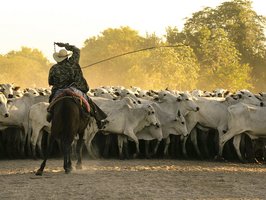
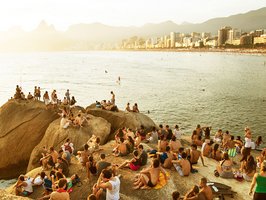
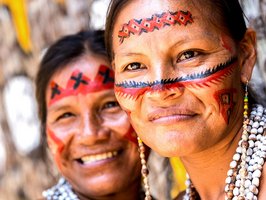
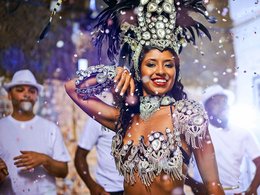
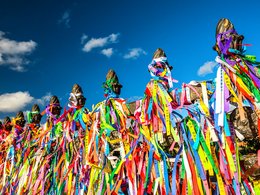
The Brazilian culture is vere heterogeneous and influenced by the many different indigenous groups and imigrants: With the colonization and the Portuguese two of the most famous celebrations - the carnival and the midsummer celebrations - came to the country. The architechture and the art was also influenced by them. Due to the colonization parts of the indigenous culture were destroyed. This process continues until today. Depending on the region, the indigenous groups are still living in there original villages and continue with there culture and traditions. Until this day there are sill discoveries of new tribes in the rainforest.
Capoeira is a free dance developed by the slaves, in which sport, culture and music is combined. Originally it comes from the states Bahia, Pernambuco and Rio de Janeiro. With the Berimbau - an instrument, made from a wooden stick, a string and a pumpkin - the main music for the capoeira is created.
About 68% of the population is part of the Roman Catholic faith. About 22% are part of the Protestant community. There also groups of natural religions and Afro-Brazilian religions like the Candomblé.
Northern Brazil with the Amazon region is taking half of the surface of the country. In the south there are some mountainous landscapes but the highest peak (3.014 m) is found in the north. Many branches of the Amazon river are flowing in he lowlands. They are devided in the Black- (Rio Negro), White- (Rio Branco) and Clearwaterrivers.
The Amazon - with a length of 6.448 km (3.000 of them in Brazil) - is the second longest river in the world. The origin of the river is in the Andes in Peru.
The different geographical regions have different names: Litoral (coast in the northeast), Agreste (high plateau in the inland), Sertao (half desert), Serras (in the southeast at the edge of the high plateaus), in South-Brazil the Restingas (lower coastal areas) and the Pampa (savanna lowlands). Addtionally there are the wavelike high plateaus in the middle west and the wet lands.
Brazil is the country with the most species diversity in the world: In the rainforest, the marchs and savanna dry regions you can find 775 species of amphibians, 520 mammals and more than 1.700 birds. There are also more than 55.000 different plants. The trees can reach an height up to 60m and are inhabited by different monkeys and parrots. Jaguar, sloths and anteaters can be found closer to the ground. Close to the water you can find snakes, alligators, turtles and capybaras. The biggest fresh water fish is the pirarucu (up to 3 m). Around 3.000 species of fish are living in Brazil.
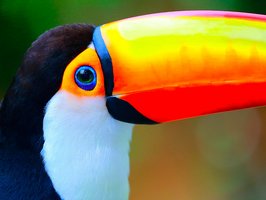
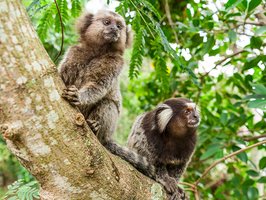
Due to the high amount of immigrants, the Brazilian cuisine is very diverse. Some of the dishes are only found in certain areas, e.g. "Gulash com Knodel" in the south or dishes with coconut milk and palm oil in the south (African influences). Further in the north the dishes are more influenced by the indigenous groups. A dish almost all Brazilians have in common is rice with black beans. Depending on the wealth it's served with meat, fish, fries or pasta and salat. Feijoada comes from the states Minas Gerais and Rio de Janeiro, where it was cooked by slaves first: Black beans with onion and rests of meat (today also sausages) are cooked together and served with rice. An example for the African influences is the Acarajé, which was originally an oblation. Today it's served as snacks on the streets. It's made of fried bean puree, which is formed into little balls and filled with prawns, tomatos, onions, pepper etc. With the Churrasco (roasted pork, beef or chicken) you can find Farofa (roasted manioc flour with egg), which is spread over the meat.
The Caipirinha known as "typical Brazilian" among tourists. The drink is made from Cachaca (sugar can liquor), lime and cane sugar. Brazilians, however, mostly prefer local beers like Skol, Bohemia or Brahma. You can buy coffee mostly on the streets from little kiosks and foodtrucks. There are two different types: one with sugared (very sweet) and one without sugar. Snacks like Pao de Quejio (small, mostly warm cheesebread-balls) or Empanadas or Salgados (fried balls from flours with cheese or meat filling) can also be found. You can also find fresh coconut water or freshly made juices.
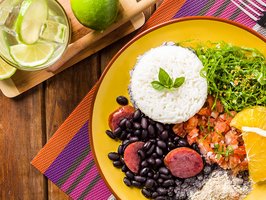
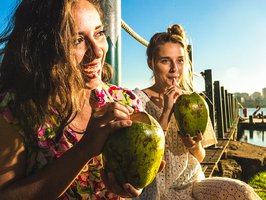
If you are well informed about Brazil now, have a look at our Trips to Brazil or contact our team.
Current Situation
Please keep in mind, that the security situation at place can change at any time. Therefore we recommend to have a look at the current safety information at Global Affairs Canada or Foreign and Commonwealth Office.
Exclusion of Liability
Those who choose to travel do so entirely at their own risk. SC Travel Adventures endeavours to inform tourists of the risks involved with travelling but cannot be held liable for any events which occur outside of their direct control. Tourists are advised to avoid areas considered unsafe, remain vigilant and cautious at all times throughout their stay, and heed the advice of local authorities.
